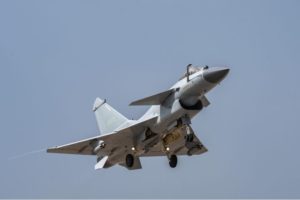
Kazakhstan Draws Lessons From the Russia-Ukraine War
By Matthew Stein
Like other countries around the world, Kazakhstan appears to be drawing lessons from the war in Ukraine to guide training for its armed forces, particularly in the use of or defense against unmanned aerial systems. In the accompanying excerpted article from Kazakhstan’s Inform Buro, Kazakhstan’s air defense forces carried out training on the “detection and destruction of drones for the first time” with the primary intent of the exercise being to “test the readiness to repulse enemy air attacks on military and civilian infrastructure.”

Air Defense Forces.
“The main goal of the exercise was to test the readiness to repulse enemy air attacks on military and civilian infrastructure.”
Like other countries around the world, Kazakhstan appears to be drawing lessons from the war in Ukraine to guide training for its armed forces, particularly in the use of or defense against unmanned aerial systems. In the accompanying excerpted article from Kazakhstan’s Inform Buro, Kazakhstan’s air defense forces carried out training on the “detection and destruction of drones for the first time” with the primary intent of the exercise being to “test the readiness to repulse enemy air attacks on military and civilian infrastructure.” The article also notes that Kazakhstani air defense forces worked on eliminating “several small-sized, low-flying targets at once” as well as destroying “high-speed targets.” While the article does not mention the war in Ukraine specifically, the scenario of the exercise resembles the types of attacks by unmanned systems being carried out in that theater of operations. Kazakhstan has always been concerned that the northern regions of the country would be annexed by Russia under the guise of protecting ethnic Russians and the predominantly Russian-speaking population. A few Russian media outlets have been critical of Kazakhstan since the war in Ukraine began, particularly after Kazakh officials announced in the spring of 2022 that its armed forces would not take part in a Victory Day parade on 9 May to mark the Soviet Union’s victory in the Second World War, but would instead carry out a training exercise to improve combat readiness.[i] These Russian news outlets went as far as to suggest that Kazakhstan could share the same fate as Ukraine. Despite this rhetoric, the governments of Russia and Kazakhstan have maintained mostly good relations since the war in Ukraine began.[ii] However, Kazakhstan’s air defense exercise shows that Kazakh officials are probably watching the war in Ukraine with concern and have carried out relevant military training to prepare for a similar conflict on its own territory.
Source:
“Силы воздушной обороны Казахстана впервые отработали уничтожение беспилотников (The air defense forces of Kazakhstan worked out the destruction of unmanned aerial vehicles for the first time),” Inform Buro (news website in Kazakhstan), 2 February 2023.
The live-firing of anti-aircraft missiles of the air defense forces took place at the Sary-Shagan training facility…According to the Ministry of Defense of Kazakhstan, soldiers trained on the detection and destruction of drones for the first time…
The main goal of the exercise was to test the readiness to repulse enemy air attacks on military and civilian infrastructure…“(they) practiced actions to detect, track, and destroy several small-sized, low-flying targets at once,” said Colonel Berik Moldakulov, commander of the air defense brigade…they also worked out tasks to detect and destroy high-speed targets.…the exercise also showed the ability of anti-aircraft missile systems to rapidly deploy…
Notes:
[i] For more information on Kazakhstan’s exercise and the cancelled parade, see: Matthew Stein “Kazakhstan Cancels Soviet-Era Parade To Focus on Combat Readiness,” OE Watch, 3-2022. https://community.apan.org/wg/tradoc-g2/fmso/p/oe-watch-issues
[ii] For more on the nature of recent Kazakh-Russian relations, see: Jacob Zenn, “Russian-Led Military Alliance in Central Asia Weakening Amid Quagmire in Ukraine,” OE Watch, 1-2023. https://community.apan.org/wg/tradoc-g2/fmso/m/oe-watch-articles-2-singular-format/434130; Matthew Stein, “Kazakhstan Suspends Defense Exports, Denying Russia Purchases,” OE Watch, 10-2022. https://community.apan.org/wg/tradoc-g2/fmso/m/oe-watch-articles-2-singular-format/427937; Matthew Stein, “Ukraine War Likely To Reduce Russian Security Commitments in Central Asia,” OE Watch, 8-2022. https://community.apan.org/wg/tradoc-g2/fmso/m/oe-watch-articles-2-singular-format/422028.
Image Information:
Image: Air Defense Forces.
Source: https://en.wikipedia.org/wiki/Kazakh_Air_Defense_Forces#/media/File:Coa_vvsrk.svg
Attribution: Public Domain
Distribution A: Approved for public release
Categories:
Tags:
Related Products
Chinese Military Exercises Highlight Improvements in Joint Operations






